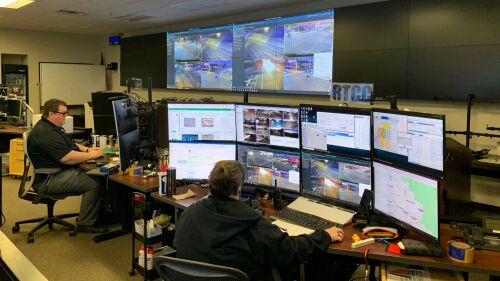Agency name: Lee County Sheriff’s Office (LCSO)
Agency size: Over 1,700 employees covering an area of 1,260 square miles in Lee County, Florida.
Population served: 1,000,000+
Date RTIC launched: 2020. Operates 24/7.
Typical calls RTIC responds to: Full range of 911-related calls, plus proactive surveillance and disaster response. The LCSO Real Time Intelligence Center (RTIC) supports local law enforcement, plus fire, EMS, state bodies and federal agencies like the DEA and FBI.
[Complete the “Get access to this Police1 resource box” on this page to download a one-page summary of this case study for easy reference.]
The challenge: Protecting the public during extreme weather
Located on the southwestern side of Florida near its tip and home to cities such as Fort Myers and Cape Coral, Lee County is no stranger to extreme weather events. A case in point: In September 2022, Category 4 Hurricane Ian devastated the coastal Lee County communities of Captiva, Matlacha, Pine Island, St. James City and Sanibel Island. Fort Myers Beach was hardest hit, with much of this tourist area flattened and washed out to sea.
Preparing and responding to extreme weather events, along with its regular law enforcement duties, is the mission of the Lee County Sheriff’s Office Real Time Intelligence Center (LCSO RTIC). Opened in January 2020, the LCSO RTIC is a 24/7 surveillance and response facility that supports public safety agencies at all levels of government. It does so using information from Flock Safety license plate readers, plus third-party imagery, body-worn cameras, drones and all other available information sources.
The solution: Eyes everywhere
To say that the LCSO RTIC’s people know what’s going on in Lee County is an understatement.
“We have electronic devices and different types of computer software programs that monitor the web completely and give us the ability to scrub social media for keywords,” said Lee County Sheriff Carmine Marceno. “We have the ability to be in every school in Lee County, and to see what is going on via video cameras at all times. Google Earth shows us where all our officers and deputies are at every moment. We can track all the planes that are flying in our region at the same time simultaneously, and also bring up all the intersections with traffic cameras.
“So when we have a call for service — let’s say we have a barricaded subject — we have the eyes in the sky that are reporting to the RTIC immediately while boots on the street are interacting live on that call. Meanwhile, our analysts are researching the history of the subject and their address, is it a violent history, do they have firearms and that type of stuff — the whole package.”
Primed for disaster
Whenever extreme weather threatens Lee County, the LCSO RTIC is ready to lighten the load for first responders.
“The RTIC is a huge part of our disaster management operation,” said Sheriff Marceno. “During hurricanes and tornadoes, analysts will work with our tactical dispatchers to facilitate rapid information gathering and sharing related to critical incidents. We monitor live cameras, scrub social media and monitor information that’s coming in. We search for reports of infrastructure failures, track dropped emergency calls with no locations and monitor for safety hazards. The RTIC will also assist with tracking resources and response and assets so we can monitor all these things simultaneously while deploying boots on the ground where needed.”
That’s not all. The LCSO RTIC has the ability to go right into tactical dispatch mode when needed, so that it can coordinate the deployment of public safety resources county-wide.
“Simultaneously, our dispatchers are communicating with other agencies,” Sheriff Marceno said. “Not only that, but we have intelligence-sharing calls that are completed weekly and we’re in direct communication with all our partners who are ready to go immediately in the event of an incident.”
The LCSO RTIC also serves as a centralized information hub during disasters, so the media and public have a trusted source they can turn to for accurate news, warnings and advice.
“The RTIC provides up-to-the-minute news updates on confirmed deceased persons, ongoing rescue efforts, storm tracking and so forth,” said Sheriff Marceno. “And simultaneously, again, we’re relaying that information both on the intelligence side to local, state and federal agencies, plus the boots on the street.”
Real results
Since launching its RTIC in 2020, the Lee County Sheriff’s Office has seen real results in improving its operations and incident response.
“We’ve had tremendous success,” Sheriff Marceno said. “Take officer safety: If an officer or a deputy goes to a house and there’s a barricaded subject — or when we had an incident at a bank with two hostages — our RTIC is simultaneously running the operation while giving intel and information to everyone who is deployed. While we are engaging that suspect, we know who the suspect is, their criminal history, and we have eyes on the subject utilizing the latest and greatest technology with the RoboDog. So as the RoboDog is getting close to the suspect, the eyes in the RTIC are watching simultaneously as the boots on the street are engaging, de-escalating and negotiating.”
The bottom line: Having an RTIC has proven to be a game changer for the Lee County Sheriff’s Office.
“We had a homicide about a year and a half ago, which would have been a case of ‘Who did it?’” said Sheriff Marceno. “Thanks to the RTIC and Flock Safety license plate readers, 41 minutes later the subject’s in custody. The implementation of the RTIC has allowed us to effectively navigate natural disasters, critical incidents and everything from recoveries to investigations. It’s the one location where you can get accurate answers and questions coming in from all the different units and divisions. It really tightens things up.”
[Complete the “Get access to this Police1 resource box” on this page to download a one-page summary of this case study for easy reference.]















